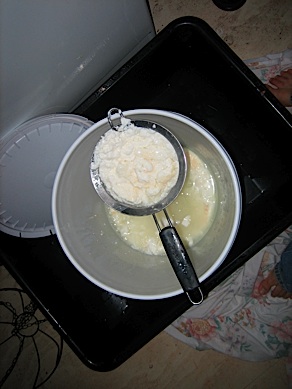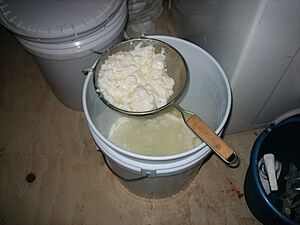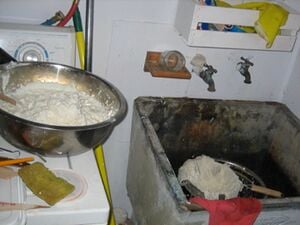
The following is a recipe for quark, or curdled milk, based paint. Quark is a Casein Paint. The recipe is very specific but casein paints last a long time, are fungi resistant and compostable. Casein paints can be used inside or outside, on wood, stone, drywall, wallpaper, earthen plaster, masonry and to cover existing painted surfaces.[1]
Milk paint is suggested for areas that will be subject to moisture. Milk paint is good for these areas because the borax (or lime) has antibacterial and anti-molding properties. When milk paint is dried it has a glassy surface that is wipeable.
See CCAT natural paint project#Milk Paint for a project that used this Natural paint.
Recipe
| Ingredient | Amount |
|---|---|
| Quark (curdled milk) | 9 ounces |
| Borax | 1 1/2 tablespoons |
| Hot Water | 1/4 cup |
| Whitening (slaked chalk) | 1/2 cup |
| Pigment (slaked) | about 1/4 cup |
| coverage approximately 22 square feet | |
Steps
First you must decide how much paint you are going to use. The above recipe estimates covering about 22 square feet. We took the square footage of our rooms, divided by 22 ft2, and then multiplied the recipe by that number. The surface area covered will also vary depending on how thick your paint comes out and the surface you are painting. Calculating how much milk you will need to make the quark is a little bit harder. The Natural Paint Book estimates 18 ounces of quark from 1 quart of non-fat or skim milk, but it is difficult to get that much especially in a cold climate (try leaving the curdling milk near your fireplace or heater). Make a batch of quark from one quart and measure how much curd you are able to get, and then base your estimates on your own results.
There is a lot of preparation that goes into making milk paint. Both the chalk and the pigment must be slaked the night before. Slaking is soaking a dry powder in water overnight so that the ingredient will mix with water in a more consistent smooth manner.
Slacking the pigment
Slaking helps reduce streaking in the paint and prevent clumps of chalk or pigment. Enough water is added to just cover the dry powder, the next day you can stir the mixture into a paste.
Curdling the milk and making the quark
Quark, the main ingredient of the paint, is just another word for milk curds. Depending on the amount of curds needed, you can make curds overnight or over a few days. This is done by pouring the milk into a container, adding lemon juice, and leaving the container in a warm place.
Once the milk has curded, you must strain the curds from the left over liquid and gently squeeze the moisture from the curds using cheesecloth. The end product is what is known as quark. Then blend the quark with an electric beater into a smooth consistency and put aside.
Dissolving the borax and mixing together
The borax needs to be dissolved into the hot water before adding it to the quark. A double boiler is recommended but we used a jar of hot water in a pot of simmering hot water. The amount of borax to hot water that the recipe calls for never allows all the borax to dissolve in the water. The recipe said to let the borax mixture cool before adding it to the quark but as the mixture cools, the borax starts to precipitate back out of the water. We did the best we could, and came to expect that some of the borax would not make it into the recipe. Let the mixture cool so that it is not hot to the touch and try to keep stirring as it cools. The borax is the first ingredient added to the quark, together these two items become the binder of the paint. Add borax mixture to bowl of quark and blend with electric beater. Then transfer binder to larger bucket.
Add prepared whitening (slaked chalk) and mix well. Then slowly add pigment to desired color.
See also
References
- ↑ Steen, B., (2006). "Make Safe, Natural Paint." Mother Earth News (218), http://www.motherearthnews.com/DIY/2006-10-01/Make_Safe_Natural_Paint.aspx [accessed 2/3/2007].
















